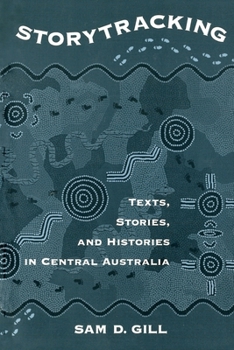Storytracking: Texts, Stories, and Histories in Central Australia
Select Format
Select Condition 
Book Overview
Storytracking is a work of theory and application. It is both a study of history and culture and the academic issues accompanying the interpretation and observation of other peoples. Sam Gill writes about Central Australia, but, more importantly, he writes about the business of trying to live responsibly and decisively in a postmodern world faced with irreconcilable diversity and complexity, with undeniable ambiguity and uncertainty.
Storytracking includes engaging accounts of many of the colorful figures involved in the nineteenth-century development of Central Australia, and it is an argument for a multiperspectival theory of history. It presents descriptions of an important aboriginal culture--the Arrernte--and it critically examines ethnography. It exposes the colonialist underbelly of all modern academic culture study, yet it embraces the situation as one of creative potential outlining an interactivist epistemology with which to negotiate the classical alternatives of objectivism and subjectivism. Gill presents an examination of the emergent academic study of religion focused on two exemplary scholars--Mircea Eliade and Jonathan Smith--offering a play theory of religion as the basis for innovative critical discussions of text, comparison, interpretation, the definition of religion, academic writing style, and the role of "the other."
Based on painstakingly detailed research, Gill exposes disturbing and confounding dimensions of the modern world, particularly academia. Yet, beyond the pessimism that often characterizes postmodernity, he charts an optimistic and creative course framed in the terms of play.
Storytracking includes engaging accounts of many of the colorful figures involved in the nineteenth-century development of Central Australia, and it is an argument for a multiperspectival theory of history. It presents descriptions of an important aboriginal culture--the Arrernte--and it critically examines ethnography. It exposes the colonialist underbelly of all modern academic culture study, yet it embraces the situation as one of creative potential outlining an interactivist epistemology with which to negotiate the classical alternatives of objectivism and subjectivism. Gill presents an examination of the emergent academic study of religion focused on two exemplary scholars--Mircea Eliade and Jonathan Smith--offering a play theory of religion as the basis for innovative critical discussions of text, comparison, interpretation, the definition of religion, academic writing style, and the role of "the other."
Based on painstakingly detailed research, Gill exposes disturbing and confounding dimensions of the modern world, particularly academia. Yet, beyond the pessimism that often characterizes postmodernity, he charts an optimistic and creative course framed in the terms of play.
Format:Paperback
Language:English
ISBN:0195115880
ISBN13:9780195115888
Release Date:February 1998
Publisher:Oxford University Press
Length:304 Pages
Weight:0.95 lbs.
Dimensions:0.7" x 6.4" x 8.6"
Customer Reviews
1 rating
Extremely Helpful Theoretical Contribution for Scholars
Published by Thriftbooks.com User , 16 years ago
Book Review: Sam D. Gill's Storytracking: Texts, Stories, and Histories in Central Australia The Skinny: This texts theoretical contributions far outweigh its deliberate focus on Australian history. It is a valuable text for anthropologists, ethnographers, historians, and religious studies scholars. Minus one star for its exorbitant list price. One danger that scholars face is the obliteration of subjects. Without getting into any of the theoretical background for this contention, we should accept (as a working proposition) that when we talk about others we are always already translating and interpreting and recontextualizing. If an informant tells you something, then you can hope to transcribe it accurately, but when you USE this quotation in a scholarly work you will inevitably reframe it for your own purposes. This leads to distortion, and this is especially true for those scholars who have studied Australia's aborigines. To start with let's take the instructive example of JZ Smith and Mircea Eliade. Both wrote about the arrente in Australia. Both relied heavily on secondary sources. Yet each scholar managed to incorporate the arrente into their work differently. On the one hand, we should expect differences. However, the other hand wags its nit-picky close-reading fingers at you. Gill skillfully deconstructs the "storytracks" created by these two scholars, identifying the differences in how they approach (and employ) their sources and explaining the implications for their interpretations. Here's the kicker: These differences reveal authors not subjects. This is an important contribution on its own, but it is Gill's clear application of his method to get to this point that makes this volume worth reading. Gill calls this method storytracking, and it intentionally calls to mind not only the "tracks" that scholars leave behind when they create "stories," but also the implication that new works are always sleuthing around, sniffing for that lead that breaks the case. While this method is far more of an abstraction than a heuristic model for interrogating sources, it does inventively re-frame the scholarly enterprise as not necessarily subject-obliterating. The big question emerges if we accept that works by scholars (often) say much more about themselves than their subjects: How can we reveal our subjects more clearly? Gill is obviously in favor of greater transparency about the relationship betwixt and between sources, and while this helps pull layers of obfuscation of subjects, it does not render them transparent. Gill's method creates a space for greater clarity, but he has really only opened the door to the possibilities of his own method. We should all eagerly await the downstream implications of this important text. PS: This book is AMAZINGLY expensive new. (What were the publishers thinking!) So be sure to grab a used copy!






